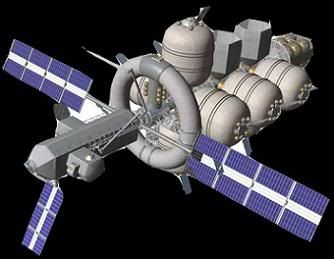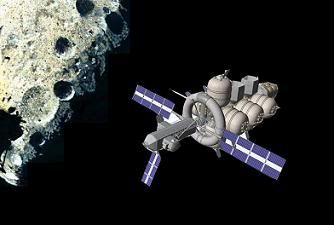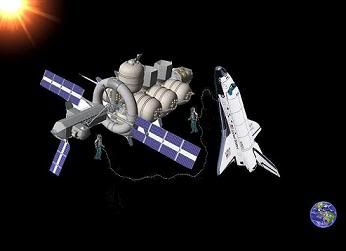Post by glactus on Mar 29, 2011 6:41:00 GMT
Now that President Obama has set his eyes on destroying NASA in its present context, the Space agency is desperately trying to keep the American dream alive and have come up with a Reusable Manned Deep - Space Craft, the. NAUTILUS-X

The Nautilus X Spacecraft
Almost a year after Launchspace contributing editors suggested an exploration vehicle that would take crews from low Earth orbit to many solar system destinations such as asteroids and lunar circumnavigation, NASA has come up with NAUTILUS-X, which stands for Non-Atmospheric Universal Transport Intended for Lengthy US space eXploration.

The Asteroid encounter
The suggested NASA version is a tubular-looking spacecfraft that could serve as a reusable vehicle, holding a crew of six and enough supplies for a two-year expedition. This vehicle would be built in orbit and, if funded, could be ready for space missions by 2020.

Inspecting Nautilus X
Launchspace originally suggested that the ISS might be a good base of operations for such a transporter.
However, NASA suggests it would be assembled from expandable structures, such as Bigelow's inflatable modules.. Part of the vehicle would contain a ring centrifuge to provide partial gravity. A radiation-mitigation system would be needed to project the crew. This might be done with tanks of water or liquid hydrogen slush.
Since Nautilus is intended to be a multi-mission exploration vehicle, it could incorporate mission-specific systems such as propulsion for high delta-V missions, or extra life support for longer coasting periods. As originally suggested by Launchspace, this approach would relieve the need to carry heavy atmospheric ascent and entry systems and structures.
However, we still need to ferry the crews from Earth surface to low orbit. At the moment, the US does not have such a vehicle beyond mid-2011, when the shuttle will be retired. Hopefully, a replacement option will soon arrive.
NASA estimates the cost to be about $3.7 billion and construction time to be at least five years. Launchspace thinks this could be an exciting international program to which many nations would be happy to contribute. Such a partnership should reduce NASA's cost considerably, and offer several Earth-to-orbit crew options.
Let's see how far the idea gets.

Nautilus X
Credits: These qre Nasa Nautilus images
Space art by Glactus
Main text by Space daily.com
www.space-travel.com/reports/A_Reusable_Manned_Deep_Space_Craft_999.html

The Nautilus X Spacecraft
Almost a year after Launchspace contributing editors suggested an exploration vehicle that would take crews from low Earth orbit to many solar system destinations such as asteroids and lunar circumnavigation, NASA has come up with NAUTILUS-X, which stands for Non-Atmospheric Universal Transport Intended for Lengthy US space eXploration.

The Asteroid encounter
The suggested NASA version is a tubular-looking spacecfraft that could serve as a reusable vehicle, holding a crew of six and enough supplies for a two-year expedition. This vehicle would be built in orbit and, if funded, could be ready for space missions by 2020.

Inspecting Nautilus X
Launchspace originally suggested that the ISS might be a good base of operations for such a transporter.
However, NASA suggests it would be assembled from expandable structures, such as Bigelow's inflatable modules.. Part of the vehicle would contain a ring centrifuge to provide partial gravity. A radiation-mitigation system would be needed to project the crew. This might be done with tanks of water or liquid hydrogen slush.
Since Nautilus is intended to be a multi-mission exploration vehicle, it could incorporate mission-specific systems such as propulsion for high delta-V missions, or extra life support for longer coasting periods. As originally suggested by Launchspace, this approach would relieve the need to carry heavy atmospheric ascent and entry systems and structures.
However, we still need to ferry the crews from Earth surface to low orbit. At the moment, the US does not have such a vehicle beyond mid-2011, when the shuttle will be retired. Hopefully, a replacement option will soon arrive.
NASA estimates the cost to be about $3.7 billion and construction time to be at least five years. Launchspace thinks this could be an exciting international program to which many nations would be happy to contribute. Such a partnership should reduce NASA's cost considerably, and offer several Earth-to-orbit crew options.
Let's see how far the idea gets.
Nautilus X
Credits: These qre Nasa Nautilus images
Space art by Glactus
Main text by Space daily.com
www.space-travel.com/reports/A_Reusable_Manned_Deep_Space_Craft_999.html


